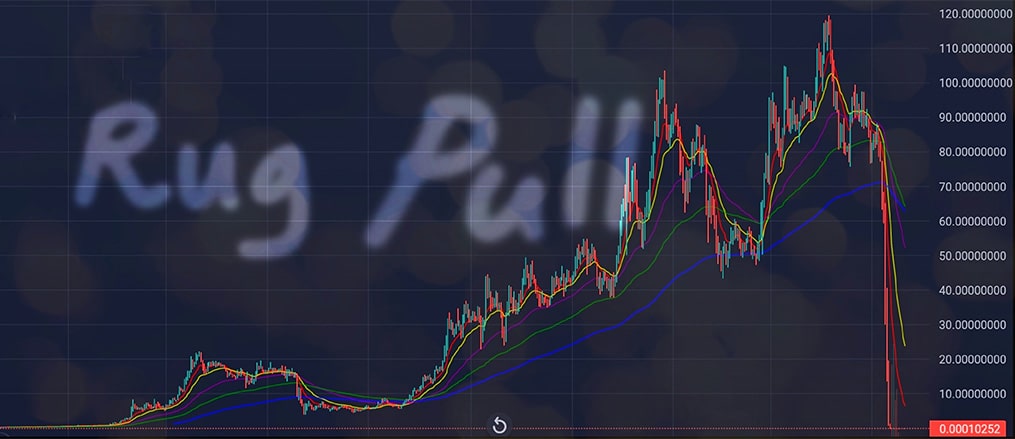Bitcoin Scams: Most Common Crypto Scams & How To Avoid Them
Our Takes:
- Bitcoin scams are common in the industry. Investors should be careful of common scams such as Ponzi schemes, phishing, and fake wallet apps.
- Do not engage with unfamiliar people or websites asking for information.
- Use a strong password, multi-factor authentication, and keep assets on a hardware wallet to mitigate crypto scams.
TABLE OF CONTENTS
Do Bitcoin Scams Actually Happen?
Yes, Bitcoin and cryptocurrency scams exist in various forms. Crypto scammers across the globe deploy various tactics, including fake websites or phishing pages, cloned mobile apps of a reputable crypto exchange, fake giveaways, Bitcoin mining scams, and more. The scammers can access the victim's Bitcoin via these websites/mobile apps that promise outrageous returns. As Bitcoin is the largest and most valuable cryptocurrency that involves anonymous transactions, it is one of the most targeted crypto assets by scammers.
Types of Cryptocurrency Scams
There are many tactics Bitcoin scammers employ to steal money from cryptocurrency investors. Usually, many of these scammers impersonate new or established crypto businesses and offer fraudulent coins or tokens to investors. Some tricksters market their scam projects on social media, create intuitive websites, and pay the most popular crypto influencers to hype their projects. That way, people consider them legitimate and are fooled into buying the coins or tokens. However, there are newer trends that scammers use since investors and exchanges are also getting smarter.
Most Common Crypto Scams To Look Out For
1. Bitcoin Investment Schemes
Bitcoin investment schemes involve malicious actors luring crypto investors with promises of huge gains. These scams are similar to Ponzi schemes but more organized and involve multiple actors. As part of the scheme, fake investment managers, who claim to have a deep knowledge of crypto trading and have made millions of dollars, reach out to investors and promise them massive returns by helping them trade crypto.
The scammers usually make money from investors by requesting a registration fee or upfront payment in the form of Bitcoin to get started with investing. Once they get the funds, they disappear into the wind. To successfully get their victims to transfer Bitcoin to them, the scammers may request identity verification and bank information, making the investors more convinced that they’ll receive payments in their bank accounts over time.
Investment scams also use the pump-and-dump mechanism during initial coin offerings (ICOs). In these kinds of scams, scammers promise that if users buy an unpopular token at a low price, its value will increase exponentially within a short period. Usually, the token is valued at a few cents or even a fraction of a cent. Victims may not have an issue purchasing them in large quantities. With numerous victims purchasing the coin simultaneously, the project gathers momentum and appears like the coin is genuinely increasing in value.

For example, in 2021, BitConnect, an offshore cryptocurrency lending program, duped investors out of over US$3 billion after promising investors 40% returns during its ICO. Novices and investors looking to make a quick profit also “bought the dip” out of excitement and FOMO, and the scammers carted away their funds. This case was one of the first crypto-related lawsuits launched by the SEC.
How To Avoid Bitcoin Investment Schemes
- Only use reputable crypto trading platforms like Binance and Coinbase
- Research every crypto project before investing
- Don’t rush into purchasing any coin
2. Rug Pulls
Rug pulls (or rug pull scams) are another popular scam in the crypto sector. Usually, these scammers spread information about a new coin or non-fungible token (NFT) that is making waves in the market and has the potential to explode. They urged investors to buy early during a presale or fund the project. Once many unsuspecting investors exchange their ETH for the token, the developers withdraw their funds, leaving investors with a valueless token.
This kind of scam usually happens in the decentralized finance (DeFi) space via decentralized exchanges (DEXs) like Uniswap and PancakeSwap. Scammers create a token and list it on a DEX, then pair it with a popular cryptocurrency like Ethereum to make it appealing and easy for investors to purchase.
Rug pulls thrive on DEXs because these exchanges are decentralized. Developers can list their tokens for a small fee, without any form of crypto or smart contract audit, unlike centralized cryptocurrency exchanges (CEXs) like Binance, where thorough audits are conducted before an asset goes live.

A popular rug pull scam was the Squid coin scam that happened in 2021. The malicious actors built the coin as a play-to-earn (P2E) cryptocurrency, urging investors to buy the token to play online games for rewards. In exchange for playing the game, investors were rewarded with additional Squid Coin tokens that they were told could be exchanged for other cryptocurrencies after they’ve been accumulated.
Many traders were bullish on the coin because of the massive increase and potential reward. Then, trading suddenly stopped, and the creators disappeared with all the money. This led to the token value falling to zero as people attempted to sell their tokens en masse but failed because the scammers had adjusted the smart contract, which prevented further token sales on the open market. According to reports, the Squid Coin rug pull earned the scammers about $3.3 million.
How to Avoid Rug Pulls
- Review the smart contract audit of the token before investing
- Check Google for the company’s registered address
- Understand the project milestones and roadmap
- Investigate the company's community
- Ask the developers questions and watch out for red flags
3. Phishing Scams
Phishing scams are one of the biggest Bitcoin risks and popular scams today. With this type of scam, malicious actors try to gain access to investors' account details, including passwords and private keys, to cart away their crypto holdings. Usually, these scammers send emails or links to fake websites to get such information and access victims’ cryptocurrency wallets. The scams often lure crypto holders into clicking or interacting with these links, and the fraudsters get the crypto wallet key information.
Don't have a secure wallet? Here's our list of the best crypto wallets.
Unlike passwords, users have only one wallet key, so if a private key is stolen, replacing it or retrieving the contents in the wallet is almost impossible because a crypto wallet has only one unique key. So phishing scammers often impersonate popular companies like banks, utility companies, e-commerce websites like Amazon, or even government agencies, luring investors with deals or other information.
For instance, a phishing website can send an email asking users to take advantage of an Ethereum giveaway or ask them to verify their crypto wallet due to an update from the company. The messages usually have links embedded that receivers can click, and the links redirect them to fraudulent websites that collect their account credentials. With these, the malicious actors can log into the associated crypto account and withdraw the investors’ Bitcoin.
A more advanced iteration of the crypto phishing scam is the “ice phishing” scam, which targets unsuspecting Web3 users into signing permissions that allow scammers to drain their wallets of funds. This scam is more advanced because the cybercriminal does not need to access the victim's private keys. They only need to trick the investor into signing permission to spend their crypto funds.
It's common in Web3 sub-sector, where users often grant approvals to DeFi protocols before use. According to data from the Federal Trade Commission, phishing scammers impersonating businesses and government agencies have accounted for $133 million in reported crypto losses since 2021.
How to Avoid Phishing Scams
- Protect computers and mobile devices using security software
- Verify website links on google before interacting with them
- Familiarize yourself with the company's branding and email accounts
- Check out the hyperlink for any misdirections
4. Ponzi Schemes
The history of Ponzi schemes traces back to the 19th century, when Charles Ponzi, an Italian swindler in the early 1920s, defrauded investors by paying old investors with the income generated from the old ones. Ponzi schemes have since evolved with technological advancements and are now very prominent in crypto. This investment fraud involves the organizers paying new investors with the proceeds from old investors who fell prey to their antics.
Usually, Ponzi scheme scammers target crypto investors because the transactions are anonymous and there's a huge appetite for insane crypto gains. The scammers design a scam investment where they lure investors with the promise of generating high and quick percentages of returns on their investment but with imaginary crypto enterprises.
The scheme thrives by receiving capital from new investors and distributing it to earlier investors under the guise that the funds are a share of the profits from the business’s legitimate investment activities. Since crypto is quite technical and volatile, Ponzi scheme operators target beginner crypto investors who do not understand how crypto works. They lure these investors with the massive potential of crypto assets and promise them attractive returns on investment (ROI). While Bitcoin is often touted as a Ponzi scheme, it does not share the same characteristics.
Eventually, the system collapses when the flow of new investments dries up, leaving the swindlers with limited resources to pay customers who have committed funds to the “business.”
A popular crypto Ponzi scheme is Onecoin. The OneCoin project was one of the longest-running Ponzi schemes ever witnessed in the crypto industry. The scheme was designed as a multi-level marketing crypto business venture marketing Onecoin as a “Bitcoin Killer” and the next big thing in the crypto industry. During its existence, OneCoin and its owner were reported to have defrauded investors of $4 billion.
How to Avoid Ponzi Schemes
- Invest in only reputable exchanges and with trusted financial advisors
- Research the crypto project to understand its nitty-gritty
- Avoid projects promising high returns
5. Social Media Scams
Crypto scams on social platforms are nothing new. According to the FTC, social media fraudsters carted away $770 million in 2021, with fake crypto investment scams accounting for a significant amount of the investors’ losses. Crypto scammers choose social channels to defraud people because they are cost-effective ways to reach billions of people around the globe. It's also a popular tactic to promote pump and dump scams in crypto.
Similarly, digital mediums support anonymity, so it’s challenging to trace crimes back to their perpetrators. Scammers can also efficiently leverage the advertising features on social channels to track people’s activities and send crypto enthusiasts personalized, fake adverts. For example, in 2021, scammers reportedly used personalized Google ads to defraud investors of $500,000 worth of crypto by directing them to fake crypto wallets.
In an era of freebies and giveaways on social platforms, crypto thieves can create accounts on various channels to push fake crypto projects with Bitcoin giveaways. Some malicious actors even pay online influencers to promote their bonuses and lure customers in.
Similarly, many fake social media handles advertise cheap Bitcoin for investors who want to buy the coin below its current market valuation. They promise huge savings—sometimes up to 5% off—to attract unsuspecting investors who believe they can buy BTC for less. However, when users click on the giveaway links, they are redirected to fraudulent websites asking them to verify their accounts to receive the Bitcoin.
Usually, the verification process includes a payment, and once an investor makes this payment via the platform, they lose the money. Sometimes, victims even have their personal accounts hacked and their crypto stolen after clicking on the malicious links.
How to Avoid Social Media Scams
- Verify projects before investing
- Don’t invest based on celebrities’ advice
- Avoid random messages on social platforms and offers about crypto investments
How to Prevent Crypto Scams
How to Prevent Crypto Scams
While crypto scammers devise smart ways to steal people’s money and crypto assets, there are several actions investors can take to prevent falling prey to a crypto scam. We highlight some tips to avoid cryptocurrency scams below.
Don't click on links or contact obscure crypto companies or agencies
Ignore any project promising unrealistic returns for purchasing or staking a token
Don’t associate with investment managers who promise to trade and grow crypto on investors’ behalf
Ignore social media influencers and celebrities contacting people to invest in a certain coin or project
Don’t respond to text messages or emails from new crypto companies
Avoid free cash or crypto from unknown sources
How To Spot Crypto Scams
Cryptocurrency scams can have a decent and legitimate outlook. However, looking out for these warning signs can help investors identify malicious actors and fake investment schemes.
- Vague or non-existent whitepaper. Usually, all crypto projects have a whitepaper detailing the project's utility, roadmap, and other information for investors to understand their offerings. For a new project, the whitepaper should also explain how the project token was designed and how it will work. Fake cryptocurrencies have poorly written whitepapers, and their figures don't add up. Investors should look out for these.
- Unnamed team members. Every project has a team behind it, and prospective investors should be able to identify these key players on the project's website, social media, or professional platforms like LinkedIn. If there are no faces behind a crypto project, it's most likely a scam.
- Excessive marketing. Marketing is typical of every business. However, legitimate cryptocurrency projects are usually pushed by their use cases and not marketing. When crypto projects invest in excessive marketing to pump their tokens, the developers may only be trying to raise money as quickly as possible.
- High returns on investment. No crypto platform can guarantee a return on investment, as crypto investments are usually considered risky. Any project promising high ROIs is most likely a crypto scam looking to defraud investors.
Tips on How to Protect Yourself from a Crypto Scam
Many scams can look convincing at first glance. But investors can protect themselves and their crypto assets from malicious actors with these crypto security measures.
- Securing wallets and private keys and not sharing with anyone for an investment opportunity.
- Testing new wallet apps with small crypto deposits to confirm if they are legitimate or compromised.
- Researching new crypto projects and understanding their teams and fundamentals before investing money.
- Checking out for pressure from investment platforms that require users to deposit funds immediately after they register.
- Downloading mobile apps from only the official platforms of any crypto project on Google Play Store and Apple App Store.
Frequently Asked Questions
How can you tell a person is a Bitcoin scammer?
Bitcoin scammers usually impersonate legitimate crypto businesses and promise large gains. They will often ask for money upfront in exchange for a future crypto service or investment. Individuals that promise ‘secret' investments and anonymous should be avoided.
Can I get my crypto back if I get scammed?
Crypto transactions are irreversible and therefore very unlikely to get back stolen crypto if scammed. However, crypto users can monitor the digital trail and inform the appropriate crypto authorities, making it harder for the scammer to liquidate the assets.




